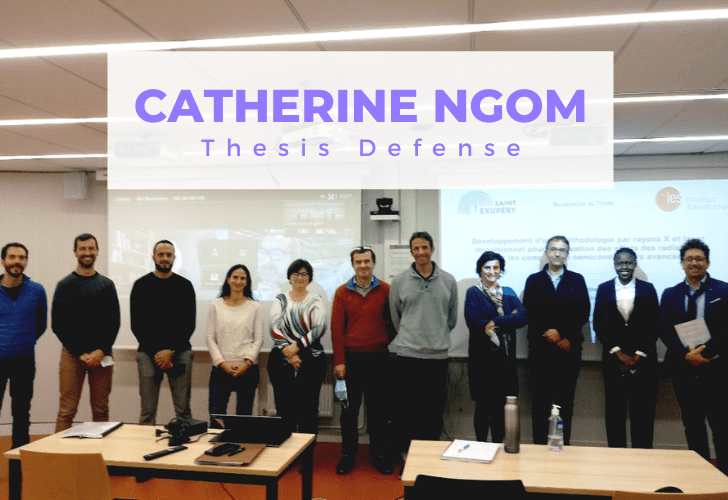On December 7, 2021, Catherine Ngom defended her thesis at the IES Doctoral School in Montpellier. Her work was supervised by the IRT Saint Exupéry in Toulouse, and the IES Laboratory in Montpellier, in collaboration with the Department of Energy Systems, Reliability and Radiation.
After winning the Best Conference Paper and Best Oral Student Presentation Awards at the RADECS 2020 Conference, Catherine – doctoral student of the Lot 2 of the FELINE Project and at the IES Montpellier Laboratory – marks another milestone with a thesis defense on advanced semiconductor components.
[UPDATE 07/12/2022] On Monday, December 6, Catherine NGOM received the Ampère-SEE 2022 thesis award during the SEE 2022 Grand Prize evening. Her thesis was realized at the IES of Montpellier and the IRT Saint Exupéry. This beautiful award testifies once again to the quality of Catherine’s work.
THESIS SUBJECT
“Methodology development using X-rays and pulsed laser for the evaluation of radiation effects in advanced semiconductor components“
ABSTRACT
New power devices technologies based on wide bandgap semiconductors constitute an interesting alternative to Silicon technologies for many applications due to their conversion efficiency, in particular in the context of the energy transition. HEMT (High Electron Mobility Transistor) type components based on AlGaN/GaN heterojunction, are particularly promising for applications in the space, aeronautics, and automotive fields.
However, electronic devices and systems exposed to radiation from the natural radiative environment (ERN), are likely to experience different types of failures induced by radiation single event effects or cumulative effects. The evaluation of the destructive effects of radiation is conventionally carried out by particle beam tests.
In this thesis, we investigated the possibility of using two complementary test techniques to evaluate the sensitivity of commercial HEMT GaN devices to radiation single event effects. The first technique, well known for Silicon technologies, consists of reproducing the transient and localized charge injection of a particle by the photoelectric absorption of a laser pulse. The second technique, which has recently emerged, consists of using a beam of focused X-rays. A state of the art of radiation effects on GaN technologies is first presented. The devices of interest in our study are then detailed, characterized, and one of them is physically modeled by finite element (TCAD).
The laser beam test technique is then adapted to the specificities of GaN on Si substrate devices. Modeling of the multiphoton absorption exploited is proposed, and the first experimental results of backside charge injection in this type of component by 3-photon absorption are shown. They demonstrate the ability of laser testing to induce non-destructive and destructive events in these devices with excellent spatial resolution, allowing the analysis of charge collection and failure mechanisms in these components to be considered.
The focused X-ray beam test technique is first explored by modeling using GEANT4*. The results of a first experimental campaign conducted at the ESRF are presented, including the observation of a destructive event. They allow identifying the current possibilities and limitations of the technique.
Finally, the previous results are compared with results from heavy-ion tests. This comparison highlights points of convergence and differences specific to each technique. A methodology for choosing the most appropriate test technique according to expectations is proposed and work perspectives are identified to continue the maturation of the complementary techniques studied.
*GEANT4: “toolkit for the simulation of the passage of particles through matter” – More information on the GEANT4 website
Scientific Publications
Published:
- C. Ngom, V. Pouget, M. Zerarka, F. Coccetti, A. Touboul, M. Matmat, O. Crepel, S. Jonathas, and G. Bascoul 2021. Backside Laser Testing of Single-Event Effects in GaN-on-Si Power HEMTs – IEEE Transaction Nuclear Science, vol. 68, no. 8, pp. 1642–1650. More information here
- C. Ngom, V. Pouget, M. Zerarka, F. Coccetti, O. Crepel, A. Touboul, and M. Matmat 2021. Modelling of charge injection by multi-photon absorption in GaN-on-Si HEMTs for SEE testing – Microelectronics Reliability, page 114339. More information here
Pending publication:
- C. Ngom, V. Pouget, M. Zerarka, F. Coccetti, A. Touboul, M. Matmat, and O. Crepel. Laser-induced Transients in a GaN-on-Si Power HEMT using Si-SPA Optical Parameters. Proceedings of the 2021 European Conference on Radiation and its Effects on Components and Systems (RADECS)
THESIS DIRECTORS AND SUPERVISORS
| Antoine TOUBOUL | Thesis Director | IES CNRS, Montpellier |
| Fabio COCCETTI | Thesis Co-Director | IRT Saint Exupéry, Toulouse |
| Vincent POUGET | Co-Supervisor | IES CNRS, Montpellier |
| Moustafa ZERARKA | Co-Supervisor | IRT Saint Exupéry, Toulouse |
JURY
| Fabio COCCETTI | Thesis Co-Director | IRT Saint Exupéry, Toulouse |
| Vincent POUGET | Co-Supervisor | IES CNRS, Montpellier |
| Moustafa ZERARKA | Co-Supervisor | IRT Saint Exupéry, Toulouse |
| Nathalie MALBERT | Reviewer | IMS University, Bordeaux |
| Patrick AUSTIN | Reviewer | LAAS University, Toulouse |
| Frédéric WROBEL | Examiner | IES University, Montpellier |
| Françoise BEZERRA | Examiner | CNES, Toulouse |
| Frédéric SAIGNE | Examiner | IES University, Montpellier |
| Cécile WEULERSSE | Guest | Airbus, Toulouse |


